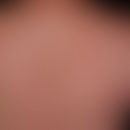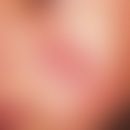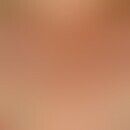DefinitionThis section has been translated automatically.
Acute, mostly histamine-mediated (usually occurring in acute or chronic urticaria), single or recurrent at irregular intervals, lasting 1-7 days, circumscribed swelling of the skin and/or mucosa. Frequent occurrence on the face (periorbital and lips), induced by massive edema formation in the subcutis. But also other lower and/or upper extremities.
Most common form of angioedema with close causal association with urticaria. Often occurring in the setting of chronic idiopathic urticaria, intolerance urticaria, or in other forms of urticaria.
Note: Occurrence of chronic recurrent ("idiopathic") angioedema is also possible without concomitant presence of urticaria, hereditary angioedema, or renin-angiotensin-aldosterone system blocker-induced angioedema (e.g., due to ACE inhibitors).
EtiopathogenesisThis section has been translated automatically.
Often IgE-mediated(similar to an anaphylactic or anaphylactoid reaction) or non-immunological mechanism. Infectious causes (dental root granulomas, sinusitis, urinary tract infections) are found in about 5% of cases. > 40% of cases remain etiologically unexplained.
In children, infections are considered the most common causes of histamine-mediated angioedema.
Viral infections (herpes simplex viruses, Coxsackie A viruses, hepatitis B viruses, Epstein-Barr viruses) and bacterial infections (otitis media, sinusitis, tonsillitis, and urinary tract infections) have been described as precipitating factors.
Parasitic infections are less common causative factors(Strongyloides, Toxocara, filariae). Helicobacter pylori has been shown to be an exacerbating factor in hereditary angioedema.
You might also be interested in
ManifestationThis section has been translated automatically.
LocalizationThis section has been translated automatically.
Clinical featuresThis section has been translated automatically.
LaboratoryThis section has been translated automatically.
Differential diagnosisThis section has been translated automatically.
Hereditary angioedema (important DD, because the therapeutic procedure differs, especially in laryngeal edema): can be excluded by the anamnestic data.
Erysipelas: High red, painful and febrile. Painful regional lymphadenitis. Leukocytosis and CRP elevation almost obligatory in acute erysipelas.
Contact dermatits: Acute contact dermatitis (especially of the capillitium) may be accompanied by significant reactive swelling of the facial skin. History of weeping pruritic scalp is diagnostic.
Photodermatitis: History, sharply demarcated, high-red dermatitis.
TherapyThis section has been translated automatically.
Note(s)This section has been translated automatically.
LiteratureThis section has been translated automatically.
- Anliker MD et al (2003) Acute urticaria and angioedema due to ehrlichiosis. Dermatology 207: 417-418
- Wedi B et al (2010) Infection focus and chronic spontaneous urticaria. dermatologist 61: 758-764
Outgoing links (15)
ACE inhibitor-induced angioedema; Ace inhibitors; Angioedema hereditary ; Angioedema hereditary 1; Contact dermatitis (overview); Coxsackie virus infection; Erysipelas; Filariasis; HHV-4; Ige; ... Show allDisclaimer
Please ask your physician for a reliable diagnosis. This website is only meant as a reference.







